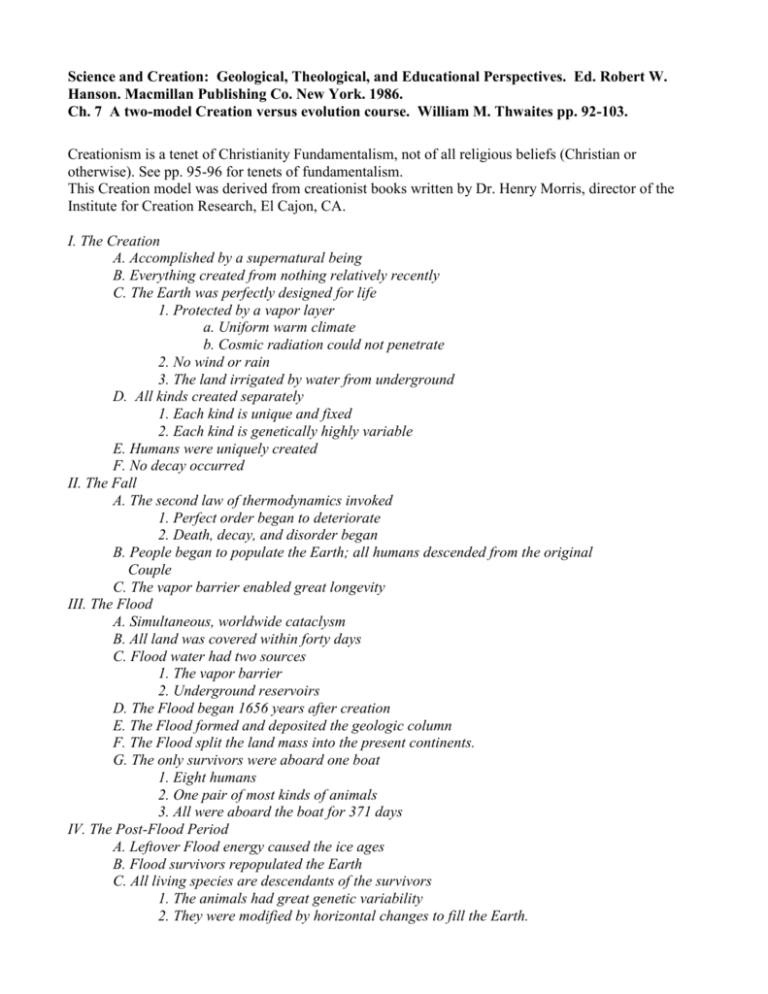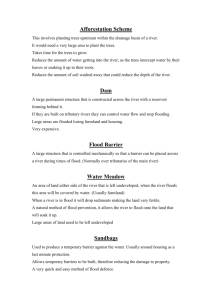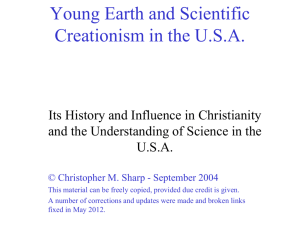Science and Creation: Geological, Theological, and
advertisement

Science and Creation: Geological, Theological, and Educational Perspectives. Ed. Robert W. Hanson. Macmillan Publishing Co. New York. 1986. Ch. 7 A two-model Creation versus evolution course. William M. Thwaites pp. 92-103. Creationism is a tenet of Christianity Fundamentalism, not of all religious beliefs (Christian or otherwise). See pp. 95-96 for tenets of fundamentalism. This Creation model was derived from creationist books written by Dr. Henry Morris, director of the Institute for Creation Research, El Cajon, CA. I. The Creation A. Accomplished by a supernatural being B. Everything created from nothing relatively recently C. The Earth was perfectly designed for life 1. Protected by a vapor layer a. Uniform warm climate b. Cosmic radiation could not penetrate 2. No wind or rain 3. The land irrigated by water from underground D. All kinds created separately 1. Each kind is unique and fixed 2. Each kind is genetically highly variable E. Humans were uniquely created F. No decay occurred II. The Fall A. The second law of thermodynamics invoked 1. Perfect order began to deteriorate 2. Death, decay, and disorder began B. People began to populate the Earth; all humans descended from the original Couple C. The vapor barrier enabled great longevity III. The Flood A. Simultaneous, worldwide cataclysm B. All land was covered within forty days C. Flood water had two sources 1. The vapor barrier 2. Underground reservoirs D. The Flood began 1656 years after creation E. The Flood formed and deposited the geologic column F. The Flood split the land mass into the present continents. G. The only survivors were aboard one boat 1. Eight humans 2. One pair of most kinds of animals 3. All were aboard the boat for 371 days IV. The Post-Flood Period A. Leftover Flood energy caused the ice ages B. Flood survivors repopulated the Earth C. All living species are descendants of the survivors 1. The animals had great genetic variability 2. They were modified by horizontal changes to fill the Earth. D. The vapor barrier was destroyed – longevity decreased E. All species degenerate since disorder must increase F. Present geological processes are different from those of the Flood. Ch. 9 Creation, Evolution, or Both? A multiple model approach pp. 128-159. Craig E. Nelson. Science by its very nature is Uncertain. We can never test all possible alternative explanations. Science then is a “blueprint of reality, not reality itself.” “The existence of uncertainty in a controversy can be understood and presented by making a preliminary list of some alternative choices. Unfortunately, the discussions of many controversies at the interface of science and society are marked by strongly presented but logically flawed dichotomies. The ‘creation, evolution, or both’ controversy is no exception. … The response of scientist has been too often to contrast (rational) science with (irrational) pseudoscience. The prevalence of these false dichotomies is understandable both in terms of dualistic cognitive structures that assume that certainty is available and that falsehood is evident and perhaps in terms of the nature of effective political persuasion.” P. 130 Spectrum of possible choices for Origins & Key Points Atheistic evolution 1. Atheism on other grounds is often coupled with imperfections in biological systems arguing against a creator. Nontheistic evolution 1. Scientific truth is objective and is (or should be) independent of religious assumptions. 2. Arguments for or against God from natural processes are logically flawed and vice versa. Gradual creation (theistic evolution) 1. Evolution is God’s way of creation (just as gravitation is God’s way of controlling the Earth’s movement). 2. Creation is the ultimate origin of the universe and continues at each moment in its maintenance. Progressive creation (limited evolution) 1. The great age of the universe, earth, and life are accepted as is the existence of as much evolutionary change as is directly shown by fossils. 2. New lineages (including humans) are regarded as separate acts of special creation. The complexity of the new forms when created increases progressively through time. Quick creation (“scientific creationism”) 1. The Earth is only a few thousand years (up to 10,000) old. 2. The geological column was formed in a year-long global flood. 3. Evolutionary “change” is only within “kind.” P. 131








